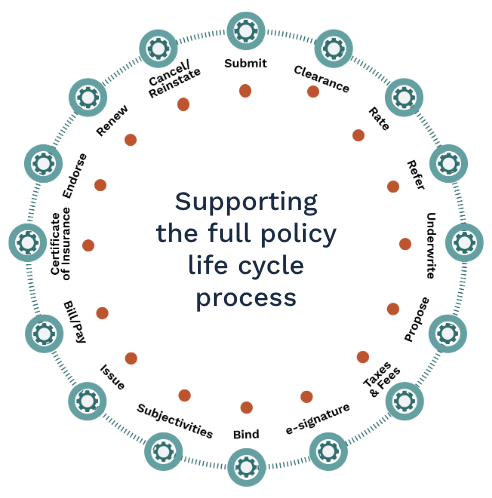It’s like the plot of every Hollywood romantic comedy. The main character stays stuck in an unsatisfying relationship because they’ve shut themselves off from other options and can’t see (until the end of the movie) that their perfect partner is just waiting for them.
For insurance carriers, it’s their legacy relationships with policy administration vendors that leave them unsatisfied—and prevent them from moving on to new technologies and business models that would better meet their needs.
ISO Electronic Rating Content™ (ERC™) is the perfect match that insurance carriers have been waiting for—enabling them to save over 35% of the cost and 30% of the time spent analyzing and interpreting ISO updates. However, taking advantage of this breakthrough technology requires companies to move on from old manual ways of doing business and embrace the new paradigm of selecting the right InsurTech partner.
What’s Holding You Back from Succeeding with ISO ERC™?
There are three main reasons why insurance companies can be reluctant to embrace ISO ERC™.
1. Traditional vendors (and most carriers) lack the necessary skills and technology
By the needs of the state-based insurance market in the U.S., ISO’s CLM is large – encompassing 20,000 pages of important information. ISO ERC™ digitizes all of this information – and keeps it current based on the critical ISO Circulars published every week—all versioned and organized by line of business and state.
Consuming and managing ISO ERC™ in a policy administration system is a complex task that requires a strong understanding of the structure of the ISO ERC™ Ratebooks and Algorithm files as they relate to the ISO Commercial Lines Rating and Circulars. It is equally critical to have a consumption tool that can handle the task of importing machine-readable data without human interaction.
The second requirement is that the target system must be architected in a way that the carrier-specific exceptions (loss cost modifiers, rule deviations, etc.) can be quickly configured “on top” of the “pure” ISO content. There can be no intermingling of the “pure” ISO content and the carrier exceptions as there are in the major systems on the market today.
These major policy administration systems are not architected with ISO ERC™ in mind, and it is either not possible, or too costly, to retro-fit these platforms for native consumption of ISO ERC™.
2. Policy administration vendors have a vested interest in maintaining the status quo
For the majority of admitted insurance companies and major system vendors, a “must-have” capability in the last 10 years has been a policy administration system that included ISO commercial lines rating and rules for all 50 states and a behind-the-scenes team of 20 to 30 business analysts, coders, and testers whose job it is to interpret the CLM and every ISO Circular published (over 75 per week).
Vendors are heavily invested in this paradigm—the amount of money and personnel required to keep this process going is staggering, and a large percentage of the revenue generated by these major system vendors is tied to the professional service fees they charge for manual ISO circulars interpretation and implementation.
ISO ERC™ eliminates the need for all of this manual processing and expense; leaving behind only the work to file and load the carrier exceptions on top of the “pure” ISO products. When you think about the financial incentives, it’s no surprise that one of the largest policy administration system vendors is claiming that “ISO ERC™ doesn’t work”. Their core business is being disrupted because ISO ERC™ provides insurance carriers a much more efficient way to use rating information from ISO.
3. Fear of failure prevents carriers from trying new ways of doing business
The history of insurance technology is littered with enterprise projects that failed to deliver on big promises. CIOs are understandably hesitant to try new technologies without proof that the project will be successful. What they’re looking for is a way to experiment with new technology such as ISO ERC™ without having to “bet the farm” on costly system implementation.
"They are fast, simple, and cost-effective. Their team is an extremely reasonable group of people who care, really care, about your success. Every launch has some bumps - they worked above and beyond to make sure those bumps didn't disrupt our launch or our ability to write new business. Without Solartis, I wouldn't be projecting a 30% increase in topline growth."
said Cameron Linder, CEO, Western Bowling Proprietors Insurance (WBPI), Rednil Insurance Brokers, Inc.
How Carriers Can Win with ISO ERC™
With the right technology and expertise, ISO ERC™ is extremely cost-effective and easy to use. The secret to success with ISO ERC™ is to select an insurance technology partner that has:
- A deep understanding of ISO ERC™,
- The tools to electronically consume the content,
- No legacy technology or personnel tied to the version update process, and
- Modular technology that can be deployed for selected products or business processes.
Solartis is your insurance technology partner
Solartis is the perfect match for companies interested in trying ISO ERC™. Unlike traditional vendors, Solartis has invested heavily in developing the ISO ERC™ skill base and the technology to digitally consume new ISO ERC™ versions within 24 hours of being published by ISO.
The Solartis Insure Platform architecture was designed with ISO ERC™ as a core component, and its carrier product exception configuration module was created to work electronically with “pure” ISO products as an underlying structure.
By using Solartis Insure for full quote and policy lifecycle for discrete admitted product offerings across the enterprise, carriers can effectively take advantage of the ISO ERC™ benefits without having to make a wholesale change in their technology infrastructure.





